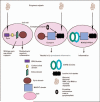The spectrum of autoinflammatory diseases: recent bench to bedside observations
- PMID: 18281860
- PMCID: PMC4565798
- DOI: 10.1097/BOR.0b013e3282f1bf4b
The spectrum of autoinflammatory diseases: recent bench to bedside observations
Abstract
Purpose of review: The autoinflammatory diseases are a group of conditions that include the hereditary fever syndromes, and result from upregulated innate immune responses. The discovery of the genetic basis for these conditions led to the description of novel intracellular receptors for infectious and noninfectious danger signals. This article focuses on recent progress in our understanding of autoinflammatory syndromes, and how insights into these conditions have triggered the exploration of the role of innate immunity in common rheumatologic diseases.
Recent findings: New models for the pathogenesis of several autoinflammatory syndromes have been proposed, including the role of pyrin and cryopyrin in regulating inflammation. Robust evidence has emerged that IL-1beta oversecretion is pivotal in cryopyrin-associated periodic syndromes, and that IL-1 inhibition ameliorates the clinical features of these syndromes. Monosodium urate crystals stimulate IL-1beta secretion via cryopyrin, which led to the addition of gout to the spectrum of autoinflammatory diseases.
Summary: Advances in our understanding of the autoinflammatory diseases have led to renewed interest in the innate immune system, and its role in the pathogenesis of more common rheumatic diseases.
Figures

References
-
- McDermott MF, Aksentijevich I, Galon J, et al. Germline mutations in the extracellular domains of the 55 kDa TNF receptor, TNFR1, define a family of dominantly inherited autoinflammatory syndromes. Cell. 1999;97:133–144. - PubMed
-
- Hull KM, Shoham N, Chae JJ, et al. The expanding spectrum of systemic autoinflammatory disorders and their rheumatic manifestations. Curr Opin Rheumatol. 2003;15:61–69. - PubMed
-
- Simon A, van der Meer JW, Vesely R, et al. Approach to genetic analysis in the diagnosis of hereditary autoinflammatory syndromes. Rheumatology (Oxford) 2006;45:269–273. [A good paper that introduces a clinical decision model to guide the use of genetic testing.] - PubMed
Publication types
MeSH terms
Substances
Grants and funding
LinkOut - more resources
Full Text Sources
Medical
Research Materials

